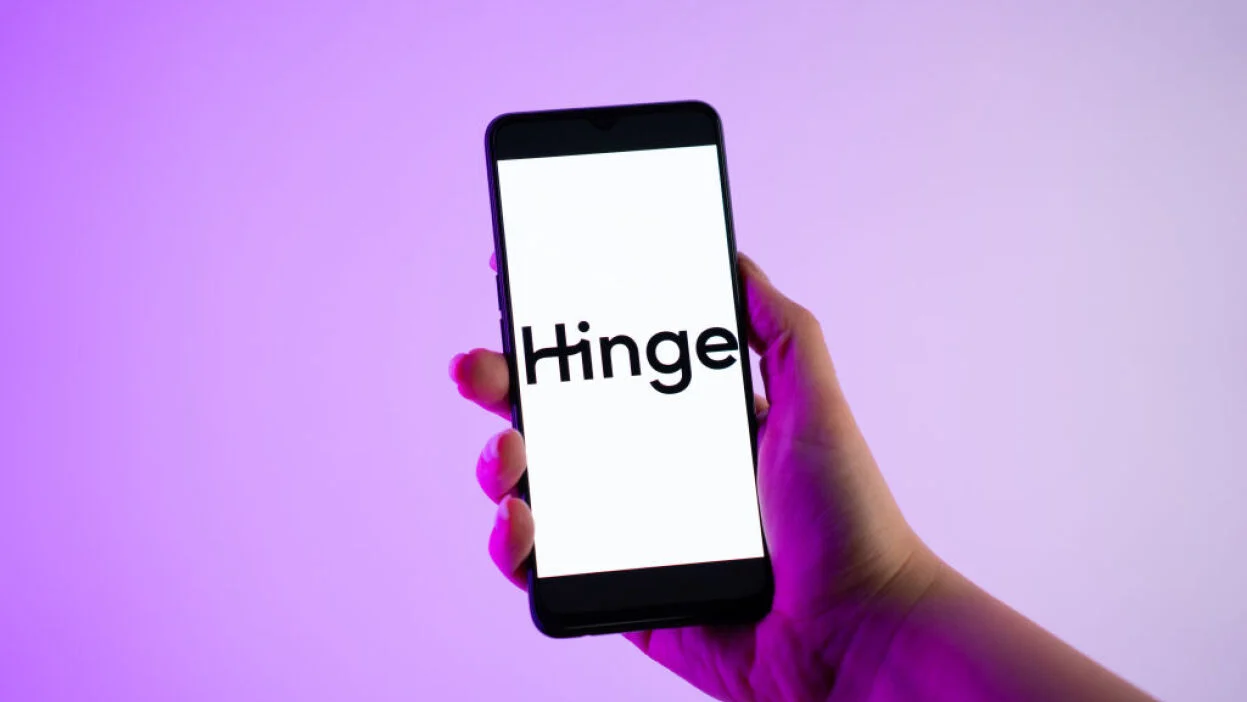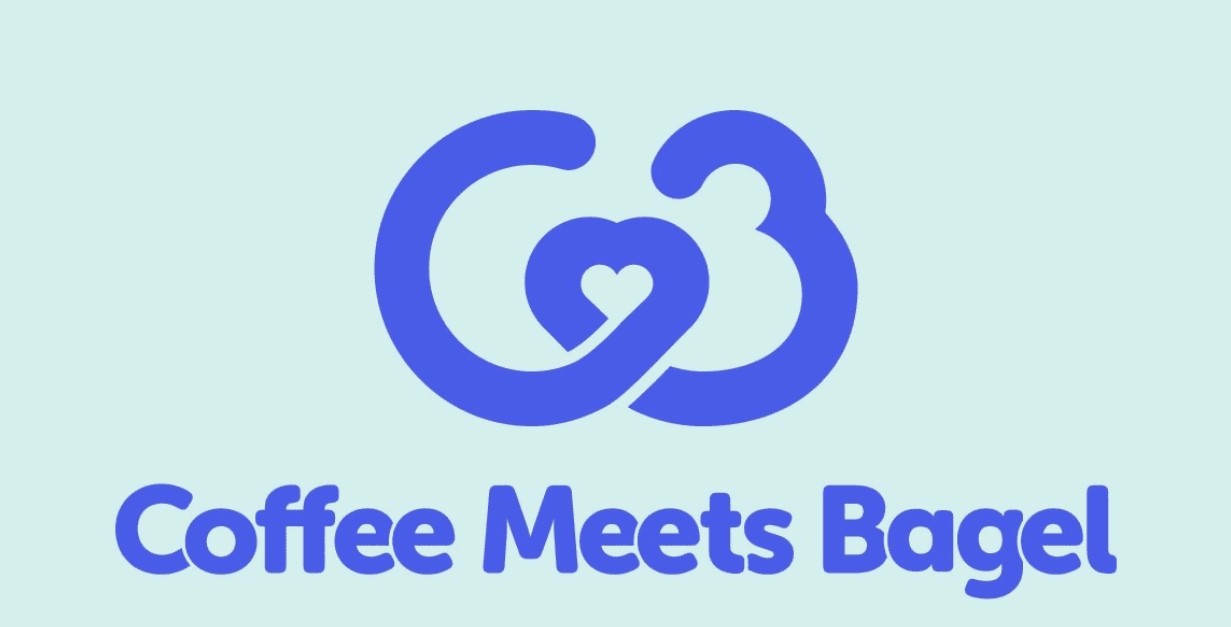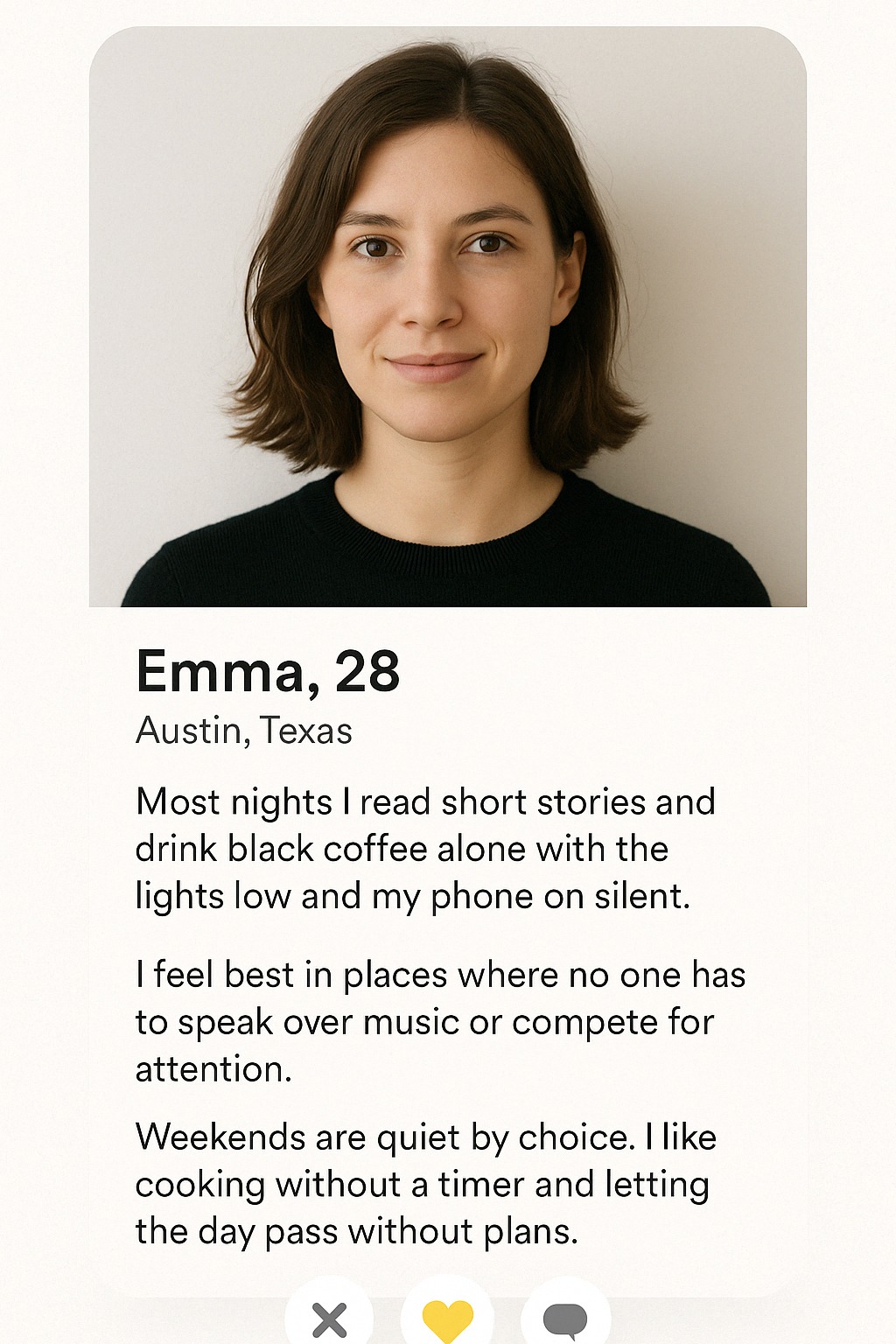
Most dating advice rewards speed, constant replies, and high energy. That structure fits people who recharge through social input, but it creates tension for anyone who prefers quiet, focus, and space. Introverts lose energy when conversations pile up, when swiping turns into pressure, and when a simple app check leads to exhaustion.
You can still use online dating to meet someone who fits you. The process must work around your habits, not against them. You need options that let you move slower, message less, and stay in control.
Each section in this guide answers a real question that comes up when dating starts to pull too hard.
Which Dating App Actually Feels Quiet Enough?
Most dating apps feel like a crowd yelling over each other. You scroll, you swipe, and suddenly it turns into a part-time job you never asked for.
Such a pace might work for someone who enjoys constant replies, but for anyone who thinks better in quiet, the whole setup feels wrong.
You need something that gives you time, space, and a clear reason to care about who shows up on the screen.
Hinge

Hinge comes closest to offering structure without chaos. Profiles have prompts instead of a single bio box, so people share specific thoughts instead of writing paragraphs you have to decode.
You can comment on a line that catches your eye instead of starting with a generic message. There is a daily limit on likes, which keeps things manageable. It feels more focused than apps built on swiping all night.
That said, some people still treat it like a numbers game. Use filters to sort that out early, and do not hesitate to leave a chat when the tone shifts into noise.
Coffee Meets Bagel

This one moves at a pace that introverts tend to appreciate. Each day, the app sends one batch of matches, and that is it. No infinite feed. No pressure to keep checking every time your phone lights up.
The layout forces you to slow down, which works better if you want fewer conversations with more intention behind each one. When a match happens, both people get a prompt to start the chat. That helps take the pressure off starting the conversation from scratch.
If you are the kind of person who likes quiet control, this setup will feel steady. It does have a smaller pool, so matches may take time to build.
OkCupid

OkCupid leans on long profiles and real compatibility questions. You can scroll through someone’s answers before you even consider liking them, which helps filter out the ones who talk but never say anything real.
The questions range from values to small habits, and you get a percentage that shows how much you match based on those inputs. That structure makes more sense for people who prefer depth over appearance.
The app can feel cluttered at times, and not everyone fills out their answers well, but if you care more about mindset than profile photos, this one gives you more to work with before the conversation begins.
Bumble

Bumble gives more control to women in straight matches, which helps set the tone early. Women send the first message. Men wait. That setup can lower pressure in the beginning. The design feels clean, and the filters are solid.
One issue is the timer. Matches expire in 24 hours if no one messages, and that can feel rushed. If you need more time to think before speaking, the countdown might work against you.
There is a snooze mode that lets you take a break without deleting your profile, and that option matters when your energy drops and you want to step back.
What Should I Put in My Profile So I Do Not Attract the Wrong People?

The right match starts with the right filter. You do not need to cast a wide net. You need to show your pace, your habits, and your preferences without forcing anything.
A clear profile keeps the wrong people away before they ever show up in your inbox. That is where energy gets saved.
Use Real Habits Instead of Broad Words

Skip traits. Skip labels. Skip filler lines. Focus on scenes. Show what a quiet night means to you. Write like you are describing a moment in your own life—not pitching an idea of what someone wants to hear.
Too Vague
“I love books, quiet nights, and good coffee.”
Clear and Personal
“Most nights I read short stories and drink black coffee alone with the lights low and my phone on silent.”
Too Flat
“Looking for someone who enjoys deep conversations and meaningful time together.”
Better option
“I like conversations that take time to build. The kind that stretch across long walks, not text threads full of one-liners.”
If Gaming Is Part of Your Routine, Bring It Up
If you spend your evenings playing games, there’s no reason to hide it or dress it up like a resume point. Mention what kind of games help you unwind, and keep it honest. If the other person seems like they’re into the same vibe, suggest playing something together.
There are plenty of low-pressure games made for two people that can lead to real conversation without forcing anything. Sometimes sharing a screen says more than a list of questions ever could.
Let People Disqualify Themselves Without You Saying No
You do not need to list dislikes. You do not need to name every dealbreaker. A strong description of what you already enjoy leaves no space for someone who wants the opposite.
Avoid This
“I am not into parties, clubs, or loud groups.”
Say This Instead
I feel best in places where no one has to speak over music or compete for attention.
That line tells someone who lives for noise to swipe past. That is the point. You save yourself the conversation that burns your attention for nothing.
Keep the Voice Consistent With Who You Actually Are
No fake confidence. No dramatic summaries. No quotes you found on someone else’s page. Write one or two full sentences that show your world. Use a photo that feels natural. Skip the one where you pretend to enjoy a place you never visit. That pressure to perform brings the wrong kind of interest.
Profile Tone that Works
Weekends are quiet by choice. I like cooking without a timer and letting the day pass without plans.
That reads like someone with a full life who is open to sharing it—on their terms, at their pace.
When you write clearly, the right kind of person will know what to say. The wrong one will keep scrolling. That is how you stay out of the noise.
How Do I Even Start a Conversation Without Feeling Fake?
Most people open with lines they do not even believe. “Hey, how are you?” or “What’s up?” fills space, but it does not move anything forward.
That kind of talk burns introverts out fast. It creates empty replies, awkward pauses, and the pressure to entertain someone you barely know.
Look for One Line That Matches Your World
No need to scroll forever. You only need one line that sounds like it came from someone with real habits. One daily routine, food pattern, or mall opinion. Anything that gives you something to stand on.
They wrote: I get up early even on weekends.
You can write: I do the same. Quiet mornings are the only part of the week that feel usable.
They wrote: I bring my own lunch to work every day.
You can write: That caught my attention. I’ve done that for years. I don’t trust microwaves or loud break rooms.
They wrote: I walk home instead of taking the train.
You can write: I do that too. That last part of the day needs silence or I lose the whole evening.
Add One Reason Without Explaining Too Much
You do not need a paragraph. One sentence about what stood out and one sentence about your own habits is enough. The goal is to speak clearly without giving more than the moment requires.
Someone writes that they cook every night because takeout feels like a waste.
You reply: That part made sense. I cook five nights a week for the same reason, and the leftovers actually matter more than the meal.
Someone writes that they listen to the same three albums every week.
You reply: I liked that detail. I rotate the same artists over and over and barely touch anything new unless someone sends it directly.
Someone mentions staying off their phone until lunch.
You reply: That’s a good move. I keep mine in another room all morning just to keep my head clear.
Send One Message. Let It Breathe.
One message should speak for itself. If they can match the tone, they will. If not, you already avoided a conversation that would not work.
Never Write Like Someone You Are Not
If you would not say it out loud, delete it. If it sounds like something you copied, delete it. If it looks like it was written for attention, delete it.
Use your normal tone. Talk like you are already speaking to someone who listens.
How to Let Someone Know You Prefer a Slower Pace With Texting
Most people expect quick replies. They send a message, check back within minutes, and assume that silence means disinterest. That pattern makes sense for people who treat dating apps like chat rooms. For someone who needs time before speaking, that rhythm feels wrong. Delayed replies are not the problem. Silence with no context is what gets misread.
Introverts often wait until they have the energy to say something that sounds complete. That delay can feel natural on your side, but it leaves the other person guessing. When nothing is said, the other person fills in the gaps. They assume you are ignoring them, or worse, leading them on. That moment becomes the beginning of doubt, even if your intention was clear.
To avoid that, you say something before the pattern forms. If a match replies fast or messages twice in a row, that is the moment to speak. You do not over-explain, and you do not apologize. One direct sentence is enough to give the right impression.
You could say:
“I reply slower, not because I’m unsure, just because I think better when I’m not glued to my phone.”
Or:
“My pace is steady, but I don’t keep the app open all day. I check it when I can give it attention.”
When you speak like that, you set a clear line. Anyone who can handle silence will stay. Anyone who panics without instant replies will show it early. That’s not rejection but rather another filter that goes in your favor.
What Do I Do When a Chat Starts Feeling Like Work?

Most conversations start out fine. The tone feels balanced, the replies land with purpose, and there’s enough back and forth to hold your attention. After a while, something shifts. The rhythm starts to fall apart. The replies get shorter, less thoughtful, and the thread begins to lose its weight. What felt steady now pulls at your energy.
That shift usually shows up in how the other person responds. You take time to write something with thought behind it, and they come back with a one-word answer. You ask something direct, and they either dodge it or ignore it entirely. That mismatch builds fast. The moment you have to start pushing the conversation just to keep it alive, it stops being a real exchange and starts becoming effort you never agreed to give.
For introverts, that drop in quality is more than just a mild frustration. It breaks your focus, drains your mental space, and leaves you wondering why you’re still responding. When a conversation stops making sense or stops feeling grounded, that is the sign to pull back. Waiting for it to fix itself usually makes it worse.
You do not owe a closing message. You do not need to explain your silence. There is no need to craft a formal exit when the thread already collapsed under its own weight. Letting it fade out is enough. That is not ghosting. That is self-respect.
If keeping the conversation alive takes more out of you than it gives back, then there’s no reason to keep going. Dating is about figuring out what fits. When something turns into a task, that answer has already arrived. Leaving that chat behind is not rude. It’s honest. And it always comes with relief.
Do I Really Need to Show My Face on a Video Call?
People treat video calls like the next required step. The chat goes well, the tone feels fine, and then the question comes.
It sounds casual—“Wanna hop on a call?”—but the timing usually feels off. For someone who needs stillness before speaking, that kind of shift breaks the rhythm. Moving into a live call too soon turns attention into pressure.
Start With How You Actually Communicate Best
Some people respond better with their voice. Others focus more clearly when they write. If speaking live adds stress, then that step should not come early. You do not need to test the connection by forcing a screen. The pace of the messages already shows how the tone is forming.
A good reply holds more value than a blurry video call where no one knows what to say. If the conversation feels balanced in text, there is no need to rush.
Say What You Prefer Without Giving a Full Explanation
You are not backing out of a date. You are saying what format fits you. That could be voice notes, text replies, or waiting until things feel more stable. One clear sentence is enough.
You could say:
“I move slower with real-time stuff, so I usually stay in text until the rhythm feels steady.”
Or:
“Video’s too much for me early on, but I’m here and paying attention when I can give it full focus.”
Notice How They React
If they respect the line, the pace stays even. If they push again or question your reason, the mismatch is already visible.
Use Other Tools That Keep the Connection Real
A phone call works better for some people. A voice note gives more tone without adding a camera. A well-written message can hold more value than a live conversation filled with awkward silence.
Let the Screen Wait Until the Tone Matches
A video call should happen when both people feel grounded—not just when one person wants to rush forward.
Where Can I Meet Someone Without Feeling Trapped?

Meeting someone in person sounds simple until the plan starts to take shape. Suddenly you’re agreeing to a loud bar, a packed restaurant, or some café where the tables are too close and the noise makes it impossible to think.
If you’re introverted, none of that works. You want to see the person. You want to speak clearly. You just do not want to feel stuck with no way to shift or exit when the energy turns sharp.
A good first meeting does not need drama. It needs air.
Look for Places Where You Can Step Away Without Excuse
You should never feel locked into a space. Parks, bookstores, and open museums give room to walk, pause, and shift focus. You can talk when it feels right and look around when it doesn’t. You can move slowly without feeling stared at. And if the energy gets heavy, leaving doesn’t feel like a scene.
You don’t need a perfect plan. You need a space where the conversation doesn’t carry the full weight of the moment.
Pick a Spot That You Already Know Feels Comfortable
It helps when you meet somewhere you’ve already been. That could be a small local coffee shop with spaced-out seating, a place you know stays quiet during off hours, or even a familiar path near where you live. If you know where to sit, where to pause, and how the place moves, you won’t waste energy managing your environment.
Comfort doesn’t come from what you’re doing. It comes from not having to overthink where you are.
Choose a Time Where No One Feels Rushed
Avoid the end of the day when both of you feel burned out. Midday works better. Early afternoon gives space before evening noise kicks in. If the time feels calm, you have more space to pace the conversation. The pressure drops, and the energy holds longer.
You’re not trying to squeeze a full story into one hour. You’re trying to see how it feels to exist around each other for a little while.
Keep the Plan Simple So You Can Leave Without a Scene
First meetings should never feel like a trap. No dinner reservations. No long events. No plans that leave you wondering how to make an exit. You pick a space with a built-in end point. Walks loop back to where you started. Coffee has a natural close. A quiet exhibit always has an exit door in sight. When the plan gives you a way out, your mind stays clear.
If it goes well, you stay longer. If it doesn’t, you leave without drama. That is what makes it safe.
How Do I Know When It Is Time to Take a Break From All of This?
Some days, the thought of replying feels heavier than silence. You read the message, but nothing in it holds your attention. The conversation moves, but the interest does not follow. Matching starts to feel mechanical. Scrolling feels like routine. Even the idea of starting one more thread begins to sound like effort. When that shift appears, it means your focus has already moved somewhere else.
When the app becomes noise, there is no reason to stay in it. A break does not require a reason that sounds dramatic. No explanation must be given. You step away the moment the process starts to feel disconnected from your voice. The break works because it gives you space. That space gives you back your attention. Once your time feels like it belongs to you again, everything starts to feel lighter. That is when it becomes possible to return without resentment. You step back in only when the energy fits.
















